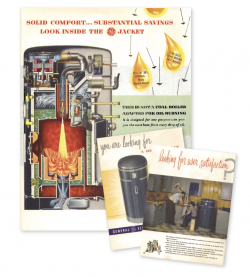All
From Blue Flame to Biofuels
by Roger Marran, Energy Kinetics

Boiler Technology Evolution through the Decades

The evolution of home heating technology and boilers has been shaped by various market forces and innovations over the decades. Hydronicheating systems date back to the 1700s, although it would take two more centuries to become commonplace. Following World War II, the rapid expansion of Levittown homes greatly expanded access to hydronic heating systems, including tankless coil boilers and radiant heat, significantly boosting market demand. Tankless coils were marketed as providing “free hot water,” as boilers maintained temperature and the coils remained consistently heated.
During this period, cast iron and steel boilers also gained popularity due to their longevity and reliability, though their quality varied between models. Meanwhile, steel boilers such as the GE Downfire demonstrated remarkable durability, often lasting more than 50 years. However, lower-quality “builder grade” steel boilers, widely sold due to their affordability, had considerably shorter lifespans.
1970s Energy Crisis and Blue Flame Efficiency
The energy crisis of the 1970s led to notable advancements in efficiency. Retention head burners emerged, reducing fuel consumption by approximately 15 percent compared to traditional 1725-rpm motor models. While these burners were noisier, their distinctive “roar of efficiency” became a selling point. Following this success, the Department of Energy aggressively promoted blue flame oil burners, leveraging commentator John Cameron Swayze in its marketing efforts.
Although initially promoted as superior, this generation of blue flame burners was later found to be unstable and to not have efficiency benefits over retention head yellow flame burners, necessitating modifications or field replacement for safe operation.
By the late 1970s, indirect tanks began replacing tankless coil boilers, offering superior energy efficiency and a continuous hot water supply. Low mass boilers, coupled with thermal purge technology, introduced solid state controls and significantly improved annual heat and hot water boiler efficiency. Additionally, the introduction of brazed plate heat exchangers further optimized hot water production by utilizing the full capacity of the boiler and enabling thermal purge for hot water for exceptional year round efficiency.
Decades of Evolution
The early 1980s saw further innovations, including sidewall venting, which more readily enabled boiler back up of heat pump installations, which were expensive to operate and provided poor comfort in cold climate applications. Sidewall vent systems also filled a market need for failed chimney systems, eliminating the need for expensive chimney repairs. By 1990, tighter new home construction benefited from direct combustion air connections to burners, isolating the heating system from the combustion air zone around the boiler. Enclosing the burner improved boiler performance and significantly reduced noise, quieting the “roar of efficiency” to a whisper. The introduction of AFUE ratings in 1992 set minimum efficiency standards for boilers, while the first ENERGY STAR specification in 1996 established a benchmark of 85 AFUE for high-efficiency models.
Throughout the late 1990s and early 2000s, condensing and combi residential gas boilers gained traction in the U.S., largely imported and rebranded by domestic companies. Three-pass oil boilers, offering better insulation and ease of maintenance, also increased in market share. However, condensing oil boilers struggled with field performance due to high sulfur content in fuel, limiting broad adoption.
New Concepts of Efficiency
A pivotal 2007 Department of Energy study revealed that boiler efficiency and annual energy savings from high performing combination heat and hot water boilers were greater than shown with AFUE ratings alone. It highlighted that low mass boilers, thermal purge technology, and well-insulated boilers and storage tanks substantially improved performance.1 Interestingly, an 87.5 AFUE low mass Oilheat boiler with thermal purge outperformed a 95 AFUE modulating condensing boiler, underscoring the gap between field performance and standard AFUE ratings. Reducing low load or idle state energy losses was shown to be a critical factor in improving actual annual efficiency.
Smart thermostats enjoyed an upswing in popularity starting in 2007, contributing to energy conservation efforts and remote access and operation. Much more broad adoption would take another half decade to develop.
The late 2000s ushered in manufacturing cost reductions and utility, state, and federal incentives for gas combi boilers, bolstering their adoption. Meanwhile, American manufacturers introduced three-pass boilers to compete with three-pass European models, cementing their presence in the market.
Cleaner Fuels, Better Boilers
In 2012, New York mandated ultra-low sulfur heating oil, setting a precedent for cleaner operation as other states followed suit. Eliminating sulfur greatly reduced boiler fouling and improved technician work environment enough so annual cleanings became annual tune-ups. At an Oilheat Manufacturer’s meeting, Arthur Marin, Executive Director of Northeast States for Coordinated Air Use Management (NESCAUM) stated that his greatest achievement during his tenure at the time was eliminating sulfur from heating oil.
The Department of Energy issued a Final Rule in 2008 rule that incorporated minimum AFUE standards along with mandated design features including an automatic means for adjusting water temperature. This rule included several pathways to compliance including temperature reset controls and cold start, thermal purge technology.
In the late 2000’s, the National Oilheat Research Alliance (NORA) issued a Program Opportunity Notice to explore sidewall venting technology. Eductors that impose a negative pressure and jet flue gasses away from the building and other technologies were tested. In 2011, building on years of success of dilution air vented gas water heaters, sidewall vented boilers with dilution air venting entered the market. Dilution air venting blends flue gases with outside air in a boiler-mounted inducer to reduce the stack temperature. Even in extremely cold and dry arctic climates, the flue gases do not condense. This technology provided a significant upgrade over traditional Oilheat sidewall venting with quieter and cleaner operation with low vent temperatures, enabling cost effective and easy to install polypropylene venting.
In 2016, NORA worked in earnest to help upgrade tankless coil boiler technology, with the goal of building on the success of gas combi boilers. In 2017, the first oil combi boiler using a conventional oil burner and hydronic controls in a boiler designed for serviceability entered the market. Priced competitively with tankless coil boilers, the combi oil boiler greatly improved hot water efficiency, annual heating efficiency, hot water delivery, and noise reduction compared to tankless coil oil boilers.
To a Renewable Future
The Oilheat industry through the Providence Resolution, NORA, manufacturers, marketers, the Clean Fuels Alliance America, and other industry partners have made tremendous strides to adopt renewable and sustainable fuels that also cut carbon emissions. Estimated at 11 percent of all residential Oilheat use in 2024, biodiesel has been an early market leader. UL 726 governing oil boilers was in flux for a few years, finally being updated to reflect blends up to 100 percent biodiesel (B100) in November 2023, when the first B100 rated boilers were approved and available for sale with B100 rated burners. These burners are compatible with blends from straight heating oil up to B100 and do not require tuning with changes in blend levels. Renewable diesel, largely regarded as an easier application for Oilheat equipment, has greatly increased in production volume and is also now available in the Northeast.
Modern innovations continue to shape the industry. Hybrid boiler-heat pump systems may offer the best of both worlds as rising residential electricity prices and winter weather comfort have driven consumers away from heat pump operation in cold climates. A simple cutover to a liquid fuel fired boiler can deliver the results desired by the consumer. This may focus on minimizing energy bills, full fuel cycle or source efficiency, comfort, or any combination. An alternative in development are fuel-fired hydronic heat pumps which can achieve remarkable efficiency ratings exceeding 140 percent. This technology shows promise for heating, but is not generally regarded as a replacement for cooling applications like air conditioning.
Firing on renewable diesel or bio-diesel could deliver a remarkable reduction in carbon intensity. Another related technology is air-to-water heat pumps (ATWHPs). While ATWHPs were initially considered as the only pathway to qualification in boiler applications for the ENERGY STAR® label, they ultimately diverged from that path. Current refrigerants limit ATWHP supply water temperatures to about 135°F, limiting their application with baseboard and cast iron radiators that are designed for 180°F water. Refrigerants that can offer higher supply water temperatures are aggressively being pursued, although safety requirements and applications need to be resolved across various regulatory agencies. The rise of web-enabled controls for remote access is another technology that may help technicians and companies with more cost effective remote diagnosis. Other app-linked controls have more advanced diagnostics and setup than available on the control itself.
The heating industry has evolved significantly, and as technology continues to advance, new solutions will drive improvements in efficiency, reliability, and sustainability.
Roger Marran is president of Energy Kinetics, Inc., a national manufacturer of innovative, high-efficiency heating and hot water systems. All Energy Kinetics heating products are manufactured in its New Jersey facility. For more information, contact Roger at rmarran@energykinetics.com.
1“Performance of Integrated Hydronic Heating Systems” (2007), Energy Resources Division, Department of Energy Sciences and Technology, BNL, Under Contract No. DE-ACO2-98CH10886 with the United States Department of Energy by Dr. T. Butcher.
Related Posts
 The Value of Providing Value
The Value of Providing Value
Posted on October 16, 2025
 2025-2026 Winter Weather Outlook
2025-2026 Winter Weather Outlook
Posted on October 16, 2025
 Gray, Gray & Gray 2025 National Energy Industry Survey Results
Gray, Gray & Gray 2025 National Energy Industry Survey Results
Posted on September 19, 2025
 New Burners Take on All Fuels!
New Burners Take on All Fuels!
Posted on July 28, 2025
Enter your email to receive important news and article updates.
